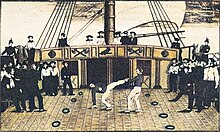
Capoeira is an Afro-Brazilian martial art and game that includes elements of dance, acrobatics, music and spirituality.

Kickboxing is a full-contact combat sport and a form of boxing based on punching and kicking. Kickboxing originated in the 1950s - 1970s of the XX century. The fight takes place in a boxing ring, normally with boxing gloves, mouth guards, shorts, and bare feet to favor the use of kicks. Kickboxing is practiced for self-defense, general fitness, or for competition. Some styles of kickboxing include: Full contact karate, Muay Thai, Japanese kickboxing, Lethwei, Sanda, and Savate.

A kick is a physical strike using the leg, in unison usually with an area of the knee or lower using the foot, heel, tibia (shin), ball of the foot, blade of the foot, toes or knee. This type of attack is used frequently by hooved animals as well as humans in the context of stand-up fighting. Kicks play a significant role in many forms of martial arts, such as capoeira, kalaripayattu, karate, kickboxing, kung fu, MMA, Muay Thai, pankration, pradal serey, savate, sikaran, silat, taekwondo, vovinam, and Yaw-Yan. Kicks are a universal act of aggression among humans.

Savate, also known as French boxing, is a French kickboxing combat sport that uses the hands and feet as weapons combining elements of English boxing with kicking techniques.

Maculelê is an Afro-Brazilian stick-dance from Bahia.

Manuel dos Reis Machado, commonly called Mestre Bimba, was a Brazilian capoeira mestre and the founder of the capoeira regional style. Bimba was one of the best capoeiristas of his time, undefeated in numerous public challenges against fighters from various martial arts.
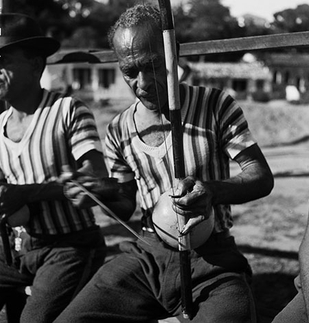
Vicente Ferreira Pastinha, known as Mestre Pastinha, was a mestre of the Afro-Brazilian martial art capoeira and a codifier of the traditional capoeira Angola style.
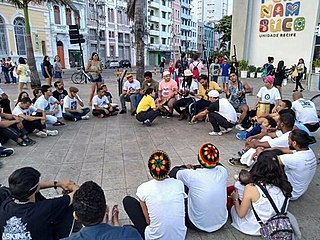
Capoeira de Angola or simply angola is the traditional style of capoeira, the Afro-Brazilian martial art. A newer style, based on the reform of capoeira Angola, is called regional.
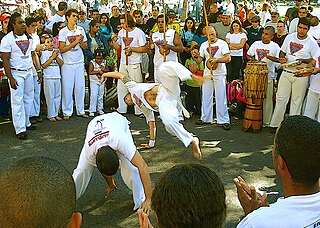
Roda is the circular formation within which participants perform in any of several African and Afro-Brazilian dance art forms, such as engolo, capoeira, maculelê and samba de roda. By extension, the whole event may be called a roda.

Canne de combat is a French combat sport. As weapon, it uses a canne or cane designed for fighting. Canne de combat was standardized in the 1970s for sporting competition by Maurice Sarry. The canne is very light, made of chestnut wood and slightly tapered. A padded suit and a fencing mask are worn for protection.
Capoeira Regional is a style of capoeira created by Bimba's reform of traditional capoeira in the 1930s. Capoeira regional is presented as a Brazilian product and as a legitimate and effective martial art.
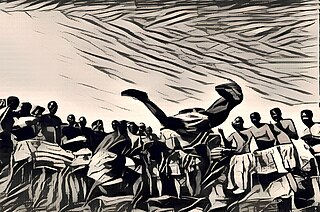
N'golo is a traditional Bantu martial art and game from Angola, that combines elements of combat and dance, performed in a circle accompanied by music and singing. It is known as the forerunner of capoeira.
Juego de maní often simply called maní or mani, sometimes referred to as baile de maní or bambosa, is a stick-fighting martial art and dance that was developed in Cuba by African slaves. It is still kept alive today in Cuba by folkloric groups. Practitioners are referred to as maniseros.
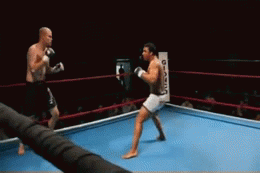
Rabo de arraia or meia-lua de compasso is a distinct technique found in the martial arts of engolo and capoeira, that combines an evasive maneuver with a reverse kick.

Agenor Moreira Sampaio, most commonly known as Mestre Sinhozinho, was a mestre or master practitioner of the Afro-Brazilian martial art of capoeira. He was the main exponent of the fighting-oriented style known as capoeira carioca.

The history of capoeira explores the origins and development of capoeira, the Brazilian martial art, that combines elements of dance, acrobatics, and music.
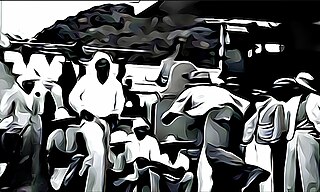
The Danmyé or Ladja is a martial art from Martinique that is similar to Brazilian capoeira and to other arts in various Caribbean islands.

Capoeira carioca was a street fighting version of capoeira that existed in Rio de Janeiro during the 19th century. In capoeira carioca, all available means were used, including various types of weapons, such as knives, straight razors, clubs and machetes. Capoeira from this period is also known as capoeiragem.

Chapa de frente or bênção (blessing) is a front push kick with the sole of the foot. In some variants, bênção can be done with the heel in the chest.
Francois Pennacchio is a French kickboxer who became WAKO champion in 1993 and 1998, and the ISKA champion in 1997. Known for his use of savate against other kickboxing styles such as muay thai, karate, and Dutch kickboxing, Pennacchio fought a total of 100 bouts against many famous kickboxers at that time, and helped popularized the use of savate in mainstream professional combat sports. Nowadays, he is considered to be one of the greatest savate fighters of all time.

